Following several days of jam-packed thought leadership, educational sessions, and enhanced networking, the 2019 ACI-NA Annual Conference and Exhibition came to an end on September 17 with a closing night event at The Vault. Our favorite phrase of the evening: ‘Cha-Cha-Cha!’ This year’s conference was an amazing celebration with nearly 2,300 registered attendees and the largest trade show floor in ACI-NA history.

|

Mark your calendars now for the 2020 ACI-NA Annual Conference & Exhibition: Sept. 13-15! See you in Grand Rapids!
Photos from the 2019 ACI-NA Annual Conference and Exhibition are available for download. Visit ACI-NA’s Flickr page to browse this year’s photos. See the photos now >>
|
>> CVG airport, library team up for jobs portal launch
The Kenton County Public Library and the Cincinnati/Northern Kentucky International Airport are teaming up to launch an online job portal this week. The portal will serve as a digital one-stop shop for airport jobs (jobs.cvgairport.com).
>> New $3.6B Salt Lake City airport opens in 1 year
As a pilot would say, the new $3.6 billion Salt Lake City International Airport is beginning its initial descent toward landing. Its first phase opens in just under a year on Sept. 15, 2020.
>> Big changes in the works for Barkley Regional Airport
The chair of the Barkley Regional Airport Authority says a project to build a new terminal would improve both comfort and safety for travelers.
>> Logan Airport offers ‘Ticket to Skip’ security line for water transportation riders
Taking the ferry to Logan could save flyers a lot of time at the airport. Those taking water transportation will now get a “Ticket to Skip” the security line. Massport said the new incentive took effect Monday.
>> Delta ends ban on emotional support animals on long flights – but keeps pit bull ban
To comply with new federal guidance, Delta Air Lines is discontinuing a ban on emotional support animals on flights longer than eight hours. However, the airline is not changing its ban on pit bulls as service animals -- even though the U.S. Department of Transportation issued guidance saying such a ban on a breed is not allowed.
>> TSA testing tablets to enroll travelers in pre-check program
To help get more travelers signed up for the TSA Pre-Check program, Transportation Security Administration officials have rolled out a pilot program at the Baltimore airport that utilizes tablets to enroll passengers.
>> FAA says each country will make ‘its own decision’ on when the Boeing 737 Max returns
The Boeing 737 Max’s return to service after two fatal crashes will be up to the safety assessment of each country, the Federal Aviation Administration said Monday. FAA Administrator Steve Dickson reiterated on Monday that the agency, which has historically taken the lead on aviation safety issues, has no set timeline to allow the jets, Boeing’s bestseller, back into the air.
>> Passengers return home after Thomas Cook collapse
One day after the British tour operator and airline Thomas Cook abruptly collapsed, leaving hundreds of thousands of travelers scrambling to make arrangements, the head of the Civil Aviation Authority in Britain promised that “nobody” from her country would be stranded and that subsidiaries in several countries were working to bring people home.
|
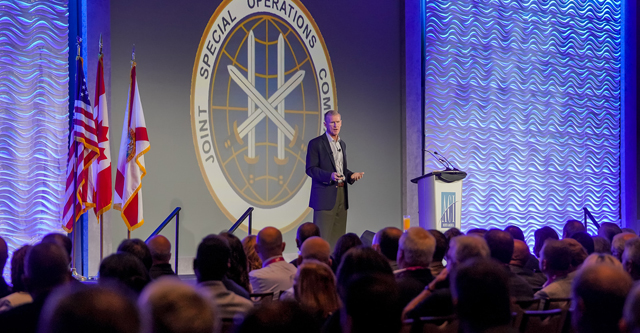
From some insightful looks at the how space flight finally achieved success to some behind-the -scenes peeks at what goes on in a 4-start general’s mind during a war, General Stan McChrystal had the conference crowd riveted during his hour-long keynote. But, for someone so accomplished, who has led troops into battle and made life-and-death decisions for thousands – if not millions - he was surprisingly down-to-earth. “The world teaches you humility,” he explained.
His comparisons and examples were so varied, that if one didn’t quite reach you, the next one would be crystal clear. For example, when it came to initial attempts at space launches, it wasn’t that any particular piece was bad, he said. It was that they didn’t all connect together seamlessly. It was the thought-process of George Mueller, a systems engineer who came into the Apollo program, that connected the pieces. He made sure that everyone understood the entire entity. Only in the context of the whole can you understand, McChrystal relayed. It is critical to success. Mueller called the success a “mundane art of management,” though McChrystal said he would add “leadership” to that as well.
He then used Frederick Winslow Taylor to illustrate how there was “one best way” that led to massive improvements in manufacturing efficiency. Then, he followed that up with an example of how efficiency is being trumped by adaptability and how “we are going to need wisdom” to conquer that one. It won’t be the kind of wisdom flowchart that we are used to, though. “Wisdom used to reside at the top,” he said. “That is not true anymore.” He said things change too fast and things shift, which is an important, life-changing concept he learned during his command of the Joint Special Operations Command. In order to beat the Al Qaeda terrorists, we had to change how we operated, he said. “For two years, they were defeating us because they were different.”
These concepts apply to organizations as well, including ACI-NA. He said the answer is to understand ourselves and where we fit in. Take, for example, a spear. It is not the tip that is dangerous; the lethality comes from the power in the shaft, which is made up of many parts/people. “How does it all come together?” he asked. “It comes together with leadership… The key is leveraging uncertainty.”
|
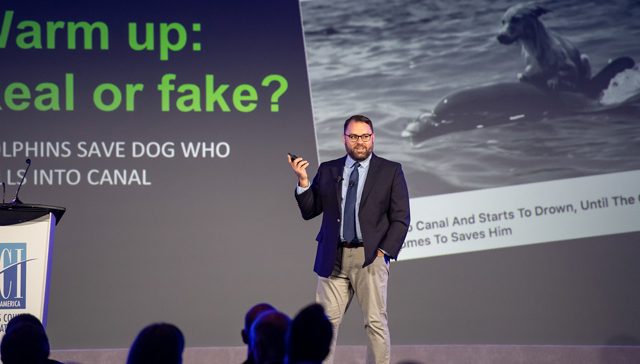
“The information space today is so complicated,” said Aaron Sharockman, Executive Director, Politifact, when leading off his keynote on Tuesday at General Session 2. “Everyone who has a phone can act like a journalist.” So the challenge becomes figuring out which news is legitimate. In an era of fake news, we are continually challenged as we separate fact from fiction, said moderator Sam Samaddar, Director, Kelowna International Airport.
Sharockman illustrated the difficulty of completing this task with a few rounds of “Real or Fake?” that were funny – but also scary. The man who supposedly took a solo flight on Delta. A dog who was rescued in a canal by a dolphin. A principal who banned candy canes. All were “real” stories, at least partially. What made them complicated was that parts of the story were real, and parts were not. It was the videos that added to the credibility, though, as they were the ones that were most believable. “This is something that keeps me up at night,” said Sharockman. “We believe things we see with our eyes. That is a big problem.” Case in point: The video featured with the dolphin-rescued dog was actually from a movie. It had nothing to do with the dog rescue.
So, how can you decide which posts are legitimate? With the “deep fakes,” Sharockman said to look for inconsistencies around the mouth, weirdness around the eyes or neck and problems with the audio. The “cheap fakes,” the ones that use manipulated or distorted video to reach misleading conclusions, can be tougher to spot. So, a good rule of thumb is to be skeptical of everything we see, in news feeds, particularly.
You can also fight back against misleading information. While there is no silver bullet, the answer is simple: “We need to get people to use their brains.”
Sharockman suggested using Wikipedia as a good place to go to source information. Also, you can do a reverse Google image search, “a powerful tool,” or something similar for YouTube videos using Amnesty International Youtube Dataviewer or InVid. There is also the practice of lateral reading, which is “super critical” and we don’t do enough of it, said Sharockman. It is where you search for information about the source, not the story. Most importantly, think critically when assessing a video.
When it comes to misinformation and disinformation, “This is a public health crisis. We all have to come together," said Sharockman. "We are fighting a war that we cannot win by ourselves." However, there is hope. "We can create a better information ecosystem.”
|
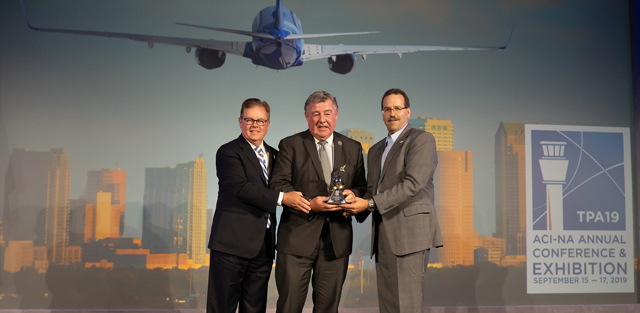
Airports Council International-North America (ACI-NA) announced that James (Jim) Cherry has been named the recipient of the 2019 Williams E. Downes, Jr. Memorial Award. The Downes Award, the highest honor given by ACI-NA, is presented to an individual who has demonstrated outstanding leadership in promoting the cause of airports and aviation throughout the local, national and worldwide communities. The award was presented during a special ceremony at the 2019 ACI-NA Annual Conference and Exhibition in Tampa, FL, on Sept. 16. Read more about Jim Cherry here.
|
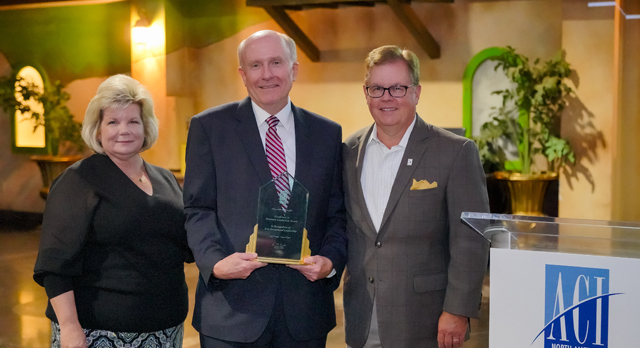
Airports Council International – North America (ACI-NA) announced that James E. Bennett, Director of Aviation Services for the city of Phoenix, was named this year’s recipient of the Excellence in Visionary Leadership Award. The award was announced during the 2019 ACI-NA Annual Conference and Exhibition in Tampa, FL.
“ACI-NA is pleased to recognize the distinguished leadership of Jim Bennett with the 2019 Excellence in Visionary Leadership Award,” said ACI-NA President and CEO Kevin M. Burke. “As the Director of Aviation Services at Phoenix Sky Harbor International Airport, Jim leads one of America’s busiest airports with integrity and the understanding that employee alignment is critical to execute a sound, unified business strategy. His dedication to PHX and its 45 million annual passengers is unmistakable, and will ensure the continued success of the airport and the local Phoenix community.” Read more >>
|
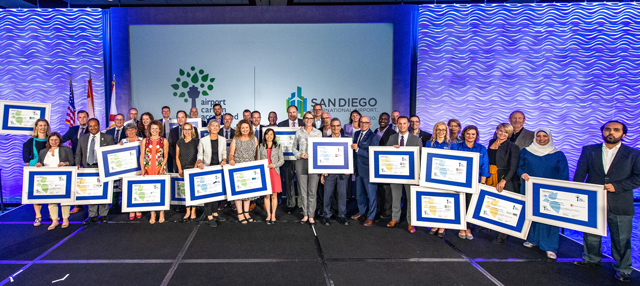
Airports Council International – North America (ACI-NA) recognized the five-year anniversary of North American airports participating in the Airport Carbon Accreditation program. The Airport Carbon Accreditation program recognizes airport efforts to manage and reduce their CO2 emissions through independent assessment and verification. Notably, San Diego International Airport was recently accredited as North America’s second-ever carbon neutral airport. ACI-NA recognized the 47 North American airports that achieved Airport Carbon Accreditation throughout the past year at the 2019 ACI-NA Annual Conference and Exhibition. Read more >>
|
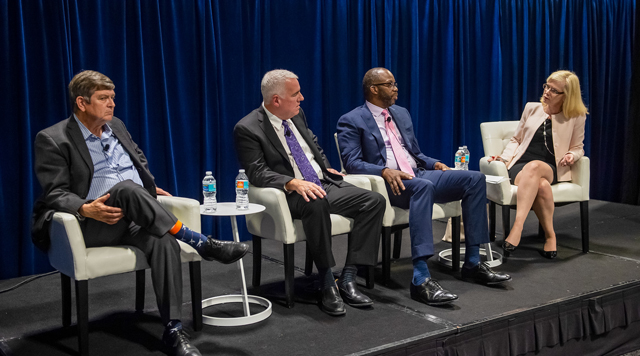
“As a leader, you have to have courage,” said Huntley A. Lawrence, Director of Aviation, Port Authority of New York and New Jersey, during the “Aligning Organizational Structure to New Demands” session on Monday. In addition, “our leaders have to be flexible and adaptable.” It is a very difficult and complex game, he said. This is especially true when it comes to how you respond to changes and how you deal with pressures at the airport, said moderator Joyce F. Carter, President & CEO, Halifax International Airport Authority. And you shouldn’t follow other airports, added Joe Nardone, President & CEO, Columbus Regional Airport Authority. You should find your own ways to drive change on a daily basis. “We will do whatever it takes to find solutions,” said Nardone. “We are a little creative and a little aggressive and we aren’t afraid to take chances.”
PANYNJ proved they were capable of exactly that, as well, when they embarked on their massive $30 billion worth of investments. “We had to look at ourselves and who we were as an organization,” said Lawrence. “We were basically landlords” and we had to look at being a top-notch airport operator, he added. They started with consolidation, then looked at everything holistically and brought in a consultant, which meant they had to be willing to dip their toes into being measured and judged, and had to be willing to communicate when they weren’t making the cut, said Lawrence. They also looked for “solid leaders” as they realized that “the engine of your organization is your people.”
Nardone also places a lot of value on staff. He suggested going out into the terminals to get in touch with what is going on with employees and with passengers. When initiating change, that is especially important. You have to have a plan, you have to communicate the plans and you have to power through, he said. “Ultimately, it is in everyone’s best interests to have dialogue.”
Tom Ruth, President & CEO, Edmonton Airports, feels similarly. What is important to me is knowing what my people want as far as organizational change, he said. It is the third, and most important, step when incorporating change: “Make sure you effectively communicate the change throughout the organization” and understand how the change will lead to long-term success, he said. The first two steps are looking at the strategy and then going through the entire organizational structure to see how the change will affect everyone. “The biggest skill we have at airports is… how we deal with change.” Our airport leaders have to be able to “’get their hands dirty,” be honest, continue to ask why and know when it is time to make the hard decisions so everyone is driving in the same direction.
|

The subject of this session “is something that is consuming a lot of time in the industry,” said moderator Candace S. McGraw, Chief Executive Officer, Cincinnati/Northern Kentucky International Airport: the passenger processing experience. But will a “happy passenger” and “airport” ever be entirely possible? Maybe not, because you cannot please everyone. But, after seeing and hearing about some of the amenities and processes incorporated at these three airports, true passenger happiness might, indeed, be a reality.
The speakers for this session were Brian Ryks, Executive Director/Chief Executive Officer, Minneapolis-St. Paul Metropolitan Airports Commission; Tan Lye Teck, Executive Vice President, Airport Management, Changi Airport Singapore; and Howard Eng, President and Chief Executive Officer, Greater Toronto Airports Authority. Each provided an overview of the types of initiatives they’ve taken to improve the passenger experience and some of the reasons behind their actions.
At Minneapolis-St. Paul, first they put together a top-notch staff then focused on their leadership strategy, all before progressing to the next steps: goals and focus areas. Ryks said they established their goals as: Safety, Security, Preparedness, Economic, Air Service, Talent, Innovation, Customer Service and Engagement. Their three focus areas became: (1) Develop new strategies to enhance financial strength; (2) Grow stakeholder and community engagement; and (3) Deliver a seamless ‘one journey’ experience for MSP passengers. Then they got to work. They implemented a parking reservation program, are building a new 5,000-space parking structure and are testing out a parking guidance system. They also worked on security passenger flow monitoring via Xovis, concessions updates such as adding grab and AtYourGate, point-of-sale data integration, biometric exit technology with Delta, and passenger flow and business intelligence.
When Teck described The Changi Experience, not only were the numbers jaw-dropping, so were the photos and video. In 2018, they had 65.6 million passengers, 386,000 total aircraft movement, 221,155 passengers on Dec. 21 and an average of 7,400 flights every week. “Every day we bring something interesting,” said Teck about their secret. “We try to go to the basics of understanding our customers.” He said this means making sure passengers don’t miss their flights, helping them from being separated from their luggage and making the flow of the airport intuitive. “We think passengers should have a clear, simple, intuitive way of finding things.” They also strive to make sure passengers feel happy on their journey through the airport. “We tried to make technology less intimidating and made it a shape and form that is easy to like.” At Jewel Changi Airport they even have a waterfall and indoor garden, a canopy park, slides and hedge mazes!
At Toronto Pearson, Eng said they have found that technology makes the process go quick and faster, “but at the end of the day, people are people.” At Toronto Pearson, they had 49.5 million passengers in 2018, so they have had a lot of opportunities to see what makes the passengers happy. “Our focus is FLOW,” he said. “We have to make the flow seamless for them.” They are also starting a known traveler digital identity program next year and have incorporated ACD-M, which allows everyone to share the same database. Signage is important to them too. “We are all working on signage,” Eng said. In this industry, we need high-tech and low-tech. “You don’t want the passengers getting lost.”
|
|
| |
|

